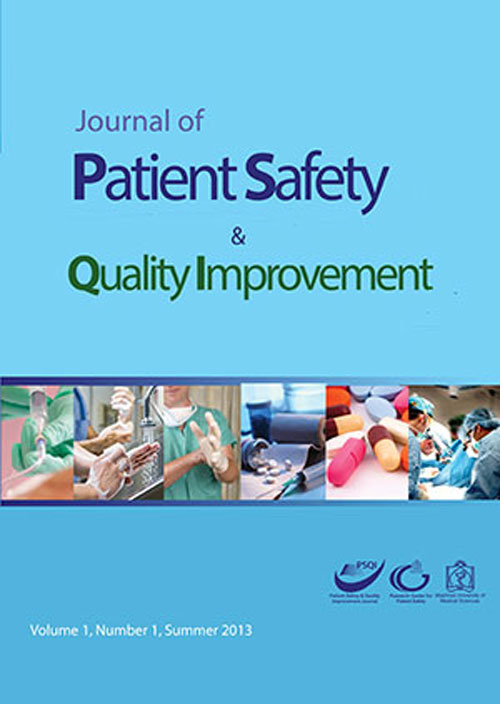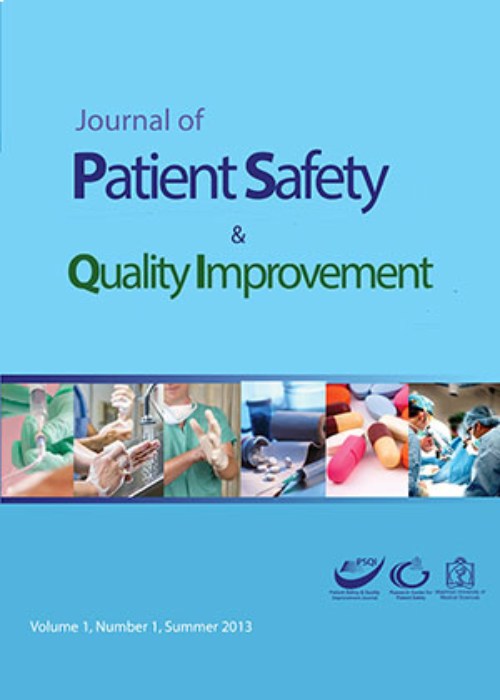فهرست مطالب

Journal Of Patient safety and quality improvement
Volume:8 Issue: 3, Summer 2020
- تاریخ انتشار: 1399/07/13
- تعداد عناوین: 8
-
Pages 127-137IntroductionMedication errors (MEs) are a common explanation for iatrogenic adverse events. This study appraised the incidence of MEs and identified the error types in the hospitals affiliated to Azad University of Medical Sciences, located in Tehran, Iran.Materials and MethodsThis cross-sectional descriptive study was conducted on all patients admitted to the hospitals affiliated to Azad University of Medical Sciences. The data were collected by means of a drug safety checklist and then extracted and analyzed in SPSS software (version 22.0). Moreover, drug interaction was assessed based on the World Health Organization guidelines and Medscape application.ResultsThe mean MEs incidence was obtained as 43.38±5.25. Moreover, the mean numbers of errors in prescribing drugs and antibiotics were 4.71±2.93 and 1.02±0.95, respectively. According to the results, drug interactions occurred in 12.3% of the medicines. In addition, ME showed a significant correlation with education status, ward type, admission type, hepatic failure, hepatic enzymes, patient weight (when on antibiotics), antibiotic effect, and patient age (65> years).ConclusionThe results were indicative of a high prevalence of prescription errors. Moreover, it was found that most of MEs were made by doctors, mainly due to the lack of an electronic drug registration system. Therefore, physicians need to be educated on how to increase patient safety through drug safety.Keywords: Hospital, Medication error, management, prescription, Storage, Usage
-
Pages 139-143IntroductionThis study aimed to validate the Persian version of the safety attitudes questionnaire (SAQ) in Mashhad, Iran.Materials and MethodsThe SAQ was distributed to 160 surgical team members at Imam Reza Hospital in Mashhad, Iran, in 2019. In total, 150 valid responses were returned. The Cronbach’s α and item-dimension correlations were calculated for reliability assessment. Confirmatory factor analysis (CFA) was also performed to assess the validity using Confirmatory Fit Index (CFI), Expected Cross-Validation Index (ECVI), and Root Mean Square Error of Approximation (RMSEA) values.ResultsThe mean age of the study population was estimated at 28.7 years, and the majority (n=116, 77.3%) of the participants were female. The goodness-of-fit index from the CFA showed a well-founded model fit (CFI=0.8, ECVI=0.8, and RMSEA=0.02). The Cronbach’s α for the scale was calculated at 0.74 within the range from 0.4 (perception of management) to 0.83 (job satisfaction). The SAQ showed good internal consistency reliability. Correlation coefficients for the association between each item and the corresponding dimensions ranged from 0.431 to 0.884, which was regarded as a good correlation.ConclusionThe SAQ was a valid and reliable instrument and could be a useful instrument to measure safety attitudes in hospitals among Iranian populations.Keywords: Iran, Reliability, Safety attitudes questionnaire, Validity
-
Pages 145-151IntroductionIdentifying errors and examining their causes in diagnostic and therapeutic processes is special conditions which has considerable impact on fertility medicine. Porpuse: The purpose of this investigation is to identifying and assessing the causes of potential errors in the Isfahan Fertility and Infertility Center using Pareto analysisMaterials and MethodsData for this study were a Descriptive-analytic study approach was adopted to assess the management practice of twofold: 1. identification of errors in process of from admission to stimulate ovulation and 2. Evaluation of causes of errors in process by using Pareto analysis.ResultsOf the 5 proposed processes, 123 errors were identified. The result ,as shown in chart1, indicate that the most common causes of error in each of the 5 processes related to "Mistake in entering the system information by personnel(13%), patient’s swarm(25%), Lack of knowledge(33%), Occupation of personnel(39%) and Doctor mistake in prescription(record, date and condition tests(45%).In fact, 80% of the causes of the error were in each of the 5 processes considered at 20% of them.ConclusionPareto chart seems to be a useful tool for identifying the main problem created by diagnostic and therapeutic processes and can identify the true cause of errors, including common errors.Keywords: Iran, Infertility, Pareto analysis, Quality, Risk Assessment
-
Pages 153-160IntroductionChildren younger than 5 years are in the fastest growth and developmental period of their lives. Regarding this, the present study was conducted to determine the effect of a developmental stimulation program on language evolution criteria in 1- to 3-year-old children with celiac disease.Materials and MethodsThis clinical trial was performed on two groups (i.e., intervention and control) of 50 children aged 1-3 years with celiac disease using random allocation technique. A developmental stimulation program was implemented for the children in the intervention group in two-hour sessions every week for 2 months. The language evolution age was evaluated by the Bayley Scales of Infant Development (Bayley-III). The data were analyzed using SPSS software (version 11.5).ResultsThe mean age of the participants was 20.6±4.4 months. Prior to the intervention, the mean age of receptive and expressive language development showed no significant difference between the two groups (P=0.672 and P=0.166, respectively). Similarly, immediately after the intervention, the mean age of expressive language development in the intervention group (21.5±3.8) underwent no significant increase, compared to that in the control group (19.1±4.5). This variable was not also significantly different between the groups in the four-month follow-up (P=0.076). Nonetheless, with regard to the mean age of receptive language evolution, this variable demonstrated a significant increase in the intervention group (24.2±4.8), compared to that in the control group immediately after the intervention (19.1±4.3; P=0.002). The results of the four-month follow-up were also indicative of a significant difference between the two groups in terms of the mean age of receptive language evolution (p <0.001).ConclusionBased on the findings of the present study, the developmental stimulation program can be used for promoting receptive language skills in children with celiac or other chronic diseases.Keywords: Child, Chronic, Development, Stimulation, Toddler
-
Pages 161-165IntroductionThe quality and safety of care and services provided to the patient are among the most important issues in the health care sector. Therefore, the present study was conducted to investigate the current status of patient safety in hospitals affiliated to Mashhad University of Medical Sciences, Mashhad, Iran.Materials and MethodsThe present study with a pretest and posttest design was carried out on 11 educational hospitals affiliated to Mashhad University of Medical Sciences. The hospitals were evaluated using the checklist of patient safety friendly hospital that is approved by the Ministry of Health. After analyzing the results with regard to the weaknesses, feedback was provided for each hospital, and then the hospitals were reevaluated by the same checklist. The data were analyzed by SPSS software (version 22).ResultsThe results of this study showed that in the first 6 months of the study within March to September 2017 before providing the feedback to the hospitals, the average accordance of hospitals with patient safety standards was 67.1% that reached 72.72% after delivering the feedback, applying patient safety standards in hospitals, and eliminating deficiencies.ConclusionHospitals should obtain the total score of the checklist to reach the patient safety friendly hospital rank; however, an average of about 75% is also significant, and planning is essential to achieve the maximum scores.Keywords: Hospital, patient, Safety
-
Pages 167-171IntroductionAnnually, more than 1.4 million of the world population suffer from nosocomial infections. The present study aimed to assess the patients' knowledge about the symptoms of hospital infections.Materials and MethodsThis descriptive cross-sectional study was conducted through the census method on 350 patients admitted to Shahid Kamyab Hospital, Mashhad, Iran. They were asked to complete a researcher-made questionnaire covering such information as demographic characteristics and questions to evaluate awareness about the symptoms of hospital-acquired infections. The data were analyzed in SPSS software (version 22) using descriptive statistics.ResultsThe majority of the participants (65%) in this study were male, and 68.7% of the cases had a higher level of awareness regarding the symptoms of hospital infections.ConclusionConsidering the higher level of patients' knowledge about the symptoms of hospital infections, the patients' education process can be continued to keep and improve this trend.Keywords: Awareness, Hospital infection, Patients
-
Pages 173-181IntroductionMedication administration error is the most common type of error in the field of medicine which is a risk factor for neonatal safety. These errors should be reported in order to prevent or mitigate their occurrence. In this regard, the present study aimed to determine the barriers of reporting medication administration errors from the point of view of nurses in neonatal and neonatal intensive care units.Materials and MethodsThis descriptive cross-sectional study was performed on 157 nurses who were selected using the census sampling method. The participants were nurses of neonatal and neonatal intensive care units in the hospitals affiliated to Shahid Beheshti University of Medical Sciences in Tehran, Iran. Moreover, the required data were collected using the second part of the Medication Administration Error Reporting Survey whose psychometric properties (content validity, face validity, construct validity, and reliability) were determined beforehand.ResultsResults of factor analysis indicated the fitness of the data of the Persian version of the scale with 16 items and four factors. Based on the findings, from the point of view of nurses, “fear” and “administrative response” were the most important barriers to reporting errors, in that order. The most and least common fears of nurses were the fear of negative perceptions and complaints of the family of patients (4.95±1.28) and the fear of reprimand by physicians (3.22±1.43), respectively. Moreover, the most important barrier in reporting the errors concerning the administrative response was the lack of positive feedback regarding the correct medication administration (4.22±1.62).ConclusionAccording to the results, it can be concluded that from the viewpoint of nurses, fear and administrative response are barriers to reporting medication administration errors.Keywords: medication administration error, Neonatal, Neonatal Intensive Care Units, Nurses
-
Pages 183-185Introduction
The mortality rate of coronavirus disease 2019 (COVID-19) has increased to more than 2-3% since it has rapidly become a pandemic. Therefore, it is aimed to prevent errors in the diagnosis and treatment of patients in case of disastrous situations.
Case ReportA 56-year-old man was admitted to the Corona Referral Center with a chief complaint of shortness of breath. He was treated for COVID-19 at least for 10 days in this hospital. Two days following discharge from the hospital, the case was spending his recovery time at home; however, since this morning he had been suffering from severe dyspnea. He was re-admitted to the Corona Center with the probability of COVID complications. The patient electrocardiography revealed a new Left Bundle Branch Block, and he was transferred to a cardiac catheterization laboratory under isolated conditions. Moreover, percutaneous coronary intervention was performed on the left main coronary artery.
ConclusionThere are always medical errors both in diagnosis and treatment since patient referrals to the emergency departments.
Keywords: COVID-19, Dyspnea, Medical error


